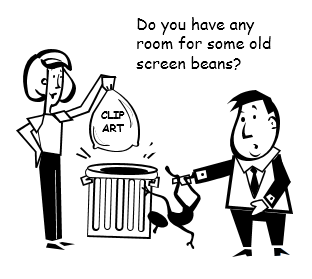I have a question. If you extensively edit images taken from the internet, can it be considered your creation? For example, whenever I download images from the internet, even if they are from paid commercial sites, I extensively re-edit them – mixing images from two different sources, re-coloring, substituting one background with another, and usually, I “behead” recognizable subjects and paste heads from other photos. The idea is to mix and match images so that a new image results. And that’s the crux of the matter: when can you consider that “new image” results?
Microsoft is Dumping Clip Art. What Are You Going to Do?
December 16th, 2014
Not sure if you saw the news, but Microsoft is going to dump clip art. In its place, you’ll have access to a Bing image search, which will be filtered by Creative Commons licensing. Theoretically the images can be used in your courses and presentations. However that may not be the case.
Here are a few quick thoughts.
Clip Art is Often Crap Art
While there’s a lot of clip art available, most of it is dated and hasn’t been updated to reflect more contemporary visual design and styles. Unfortunately many of those images end up in presentations and elearning courses. Because people tend to mix and match these images, some of the presentations and online courses are a bit discordant. They lack a coherent visual design and fall into the Frankencourse category.
In that case dropping clip art is probably a good thing for course designers. It forces us to be more intentional about the graphics we use in our courses. It also puts some pressure on organizations to finally commit some of their training budgets to graphic and visual design resources.
Vector Illustrations Rock
Clip art gets a bad rap but you don’t see the same complaints about “vector illustrations.” However, most clip art images offered through the Microsoft site are actually vector illustrations. So if you’re still using clip art from the site, start calling them vector illustrations. And later when you need money for illustrations, you’ll sound more sophisticated and avoid some of the eye rolling you’d get asking for a clip art budget.
What’s the difference between vector and bitmap images?
Bitmap images are a grid of cells we call pixels. For example, if an image is 300×300 it is going to have 300 pixels from left to right and 300 pixels from top to bottom to form a grid of 90,000 pixels. If the image is scaled up, the pixels become larger and we get that blurry pixelated look. That’s not good.
![]()
Vector images are based on a mathematical formula to draw lines and shapes. When you scale a vector image it remains crisp because you’re not scaling pixels. Vector images also tend to have smaller file sizes because they have to store less information about the image.
The most common image formats are .JPG, .GIF, and .PNG. Those are bitmaps. In PowerPoint, the most common vector images formats are .EMF and .WMF.
Clip Art Offered a Lot of Options
Many of you work with limited resources so the free clip art vector illustrations that Microsoft made available was important to getting your work done. What makes vector illustrations great for work in PowerPoint is that not only do you always have crisp images, you can also ungroup them to their individual parts. That means they can be recolored and edited to meet the needs of your projects. That’s not as easy to do with a bitmap image which requires more editing.
Here are a few tips:
- Take advantage of the free resources now and save what you can from the site before it’s gone. Here’s a link to the clip art site if you can’t find it.
- Plan on asking for an assets budget when you begin work on your courses. Also, if you need specific images where will you get them?
- Find cheap alternatives. Sometimes you can find old software applications at used bookstores. For example, it seems there are always greeting card creators in the discount bins. They usually have disks loaded with images. I buy them whenever I see them in the discount bins.
- Learn basic image editing so that you can begin to create and edit your own graphics. Once the clip art site is gone, you’ll have to do more to create the right images for your courses. Now’s the time to learn some basic editing techniques.
Creative Commons Beware
I like that the Bing search feature will default to a Creative Commons filter. In theory, all of the images should work for your presentations and courses in some manner.

However, creating a student project or presentation is a bit different than creating a professional and commercial elearning course. That means you’ll need to verify that the images you use via the Creative Commons search can be used for commercial work. This requires a lot of extra work because you need to find images and then search their sites for the appropriate license.
I did a few image search tests and while the sites that hosted the image may have been under some sort of Creative Commons license, many of the images were not necessarily owned but the site author. In my tests, there was nothing to indicate that the site owner actually had rights to the image for me to use.
So basically, you can’t trust the images you find in the search. You’ll have to do a lot more digging if you want to use those images in your projects. Here’s a post I did on ways to attribute Creative Commons images when you use them in your courses.
Personally, I’m kind of bummed about the decision to drop the free clip art available from the office.com site. Years ago I worked for an organization that had no money for my projects. I took a lot of pride in MacGyvering the free PowerPoint clip art and making my own images. I was always able to create what I needed and it’s been a cool trick to show at workshops, too.

I’m sure many of you are in the same boat. You work for organizations that have no budget for graphics and illustrations and you don’t have resources to help create what you need. If you are one of the ones who depends on the clip art site, what’s your plan going forward? What suggestions do you have for the other blog readers? Share it with is in the comments section.
Events
- Everyday. Check out the weekly training webinars to learn more about Rise, Storyline, and instructional design.
Free E-Learning Resources
 |
 |
 |
|
Want to learn more? Check out these articles and free resources in the community. |
Here’s a great job board for e-learning, instructional design, and training jobs |
Participate in the weekly e-learning challenges to sharpen your skills |
 |
 |
 |
|
Get your free PowerPoint templates and free graphics & stock images. |
Lots of cool e-learning examples to check out and find inspiration. |
Getting Started? This e-learning 101 series and the free e-books will help. |
38 responses to “Microsoft is Dumping Clip Art. What Are You Going to Do?”
Never fear, Microsoft clip art is still accessible online…just not as a direct link through PowerPoint. Many moons ago, Tom shared information on styles in Microsoft clip art. I bookmarked a few of my favorites and they are still available, which means that Microsoft clip art is still available. Here is a link that will get you to clip art goodness: http://office.microsoft.com/en-us/images/results.aspx?qu=Style%201270#mt:0|
My suggestions for building great, consistant and relevant artwork for eLearning are to:
1. Partner with an artist/cartoonist, possibly an art student who needs to build up a portfolio and will work for cheap to get their feet wet with sales and exposure.
2. Take specific photos yourself. Using a modern phone camera or even an entry-level DSLR on auto can yeild clear, consistantly themed and relevant photos.
3. Name your price and your particular need for phtographs on Snapwire or other photo sites. Just put in a request with specifics and photographers submit photos for you to choose from. Good luck all!
It would be a great thing if all clip art had its license model and copyright owner embedded in meta-data as EXIF or ITPC or the like… It would be a lot easier to find if we can use an image.
I think most picture formats support some kind of metadata. Please let clip art makers know! 🙂
I spent waaaay too long looking for WMF and EMF files last night for a demo project. These were always available in Clip Art. I found NO success searching Bing and it turned me off using it even more!
Bring back Clip Art Microsoft!!
You only miss it when it’s gone..
The main site I use is PhotoPin as you can initially select commercial or noncommercial licenses. If you select Get Photo on a photo, which opens in a popup, you can easily tell its copyright. For example, if it opens in ShutterStock, it will say who holds the copyright. If it opens and has a link that contains “http://creativecommons.org/licenses/by-nc/2.0/”, you will start figuring out the CC nomenclature (e.g., by = give attribution to the artist; nc = non commercial). Because the other things are absent, that means you can share and adapt the image.
The other site I use is Yahoo images “The Commons,” which is a collection of copyright-free images (normally older, https://www.flickr.com/commons/). Their regular search isn’t bad, and once you have put in a search, you can restrict the photos to CC, but you have to click on the photo to see the restrictions. You have to get to know the CC icons to quickly recognize the restrictions, but once you have those down, it’s easy to filter through the graphics.
To answer the question posed in the headline:
I guess I’ll have to find another source of clip art to not use.
I’m also bummed by the decision. I actually asked Microsoft more than a year ago to get rid of the older clip art and commission more modern art, but I didn’t anticipate this. Also, no one has really made clear if this means that Microsoft is dumping all of its wonderful (bitmap) photos. What a shame. As you mentioned, finding if an image really does have Creative Commons licensing is difficult and finding what to put in the attribution label is too. Finally, attribution labels clutter up your slides!
I’ve been in the eLearning/CBT industry since the mid 1980s and have worked on many courses in this time both as a graphic designer/art director and as a programmer.
I think a fundamental flaw in many eLearning programs is allowing an instructional designer/courseware developer to take on the role of graphic designer. It really degrades the value of the graphic design professional and perpetuates the belief that corporations can get by without their services just because there’s a myriad of clip art/stock photography options available.
We’ve all heard the phrase, “content is king.” Even the best content will suffer from poorly executed visuals that have been crow-barred into a solution. Graphic design is about visual communication and, in the context of an eLearning course, helps bring clarity to the content by using conceptual images and animations. It gives a richer and more engaging experience for learners that cannot be obtained through ill-conceived images and photography.
If you’re developing commercial products for market, this becomes even more important. When a customer purchases training, they will expect a degree of professionalism from both the course’s instructional design as well as its visual design. Having only one piece of that puzzle can have a very negative impact in terms of whether that customer will purchase another course.
This article should have a section about the importance of graphic design and how instructional designers should present the case to management for seeking out a graphic design professional to assist in their next eLearning course.
The instructional designer would be putting a good deal of time into researching images, their usage, seeking out clip art and/or stock photography, paying for clip art and stock photography and then doing all of the production work. That equates to a lot of time and money.
Why not produce better courses twice as fast by hiring a design professional? If you look at the expense of hiring a designer versus time spent looking for and purchasing images, it makes no business sense not to hire the professional. Most designers work efficiently and are not going to break the bank.
Thanks for reading.
I will absolutely miss Clip Art, especially since I’ve had lots of fun using it as a base for my own constructions since Tom taught me how. I’m wondering what the copyright issues are with the Bing Creative Commons art if you modify the image substantially?
My suggestion for alternatives is Shutterstock’s 30 day plan http://www.shutterstock.com/subscribe. For about $249, you get 25 image downloads for 30 days. You can plan ahead and put them into a lightbox or two if you don’t want to scramble every 24 hours to find what you need. They have both vector and photo options, and they have options for finding items with the same model or same developer. I usually edit them with PowerPoint’s remove background and other photo editing features before I put them into Articulate. It’s not free but it never drains my budget because I can usually get all the images I need for a project during the month.
This is a bummer. I was just getting into modifying Microsoft clipart using Tom’s tutorials.
One alternative is vectorstock.com. They have really high-quality graphics and the rates are generally $1 per graphic – much less than lots of sites.
Hey Tom,
Maybe Articulate could take over Microsoft’s clip art library and keep sharing it?
It would be a benefit to the community and it would be useful advertising to the rest of the world.
I’m not a freelancer. I do courses for the company I work for. Is my work still considered to be commercial? I’m not profiting from it.
Unfortunately some things Microsoft says are free, they later decide will not be. In my case a small business web site platform. Simple for solo enterprises like mine.
In this case maybe they don’t think they can compete w Google w/o opening things up to outside Microsoft. A cynic might say they’re getting the users to create assets for them. But that’s a different discussion.
Tom,
Thanks much for the Heads Up. I like Joe Kirby’s suggestion.
I also use Pixabay ( http://www.Pixabay.com ), and they allow searches by Vector Images only, as well as Illustrations and Photos.
One of my favorite contributors on Pixabay is “Nemo”
http://pixabay.com/en/users/Nemo-3736/
“Nemo” has a ton of free images available.
Hope the above helps someone.
@jenisecook
I like Joe’s idea! eLearning Heroes! 🙂
I too am bummed about this! Firstly, it’s a pretty easy search and I dislike Bing as a search tool.
I saved a bunch of clip art styles onto dropbox a while ago. I will be sure to do the same before it goes completely.
However, I have found that more and more I have been creating my own graphics and more and more from scratch.
I’m not a graphic designed by any means, but like Tom, I have an eye for design. I’ve even had people ask where I purchased some of the images I created!
I had a previous manager who hated clip art – and it took me a while for me to understand what he meant. He hated the images that look like an amateur has put them together. And this usually occurs from using clip arts from a range of styles.
For me, the aim is always about graphical representation to support the learner in understanding the content – rather than making a document ‘look pretty’.
I also hate photos unless they graphically support the learning content.
To this end, I usually broke up images. But I also liked that MS clip art had a wide variety of cut outs which I use heavily.
Well, just a new challenge! Lol!
The Noun Project just revised their usage terms. Now more of their work is Creative Commons attribution. There is also clip art that is in the Public Domain but you have to hunt for it.
I have been using the site for some small projects. It won’t work for many folks but if you can make use of the icon b/w stick people it is a good place to check out http://thenounproject.com
Like many others, I subscribe to Bigstock or iStock photo. Also, just a quick plug for eLearning Brothers. I use their cut-outs above and beyond what comes with Articulate, Lectora etc… Admittedly, I will miss some vector illustrations. Years ago, I used a running theme of coffee cups and I used to swap out the color of the cups or edit the cups with a different logos. Too bad.
OMG!!! That´s the worst news!! Tom – I can remember you once shared which clipart style you use the most. I can´t find the post – could you please re-share, so I can start downloading 🙂
Thanks 🙂
Copyright and Creative Commons issues are much more complex than some of the comments above suggest.:
1. Is that image you found on Flickr/Bing/Google etc actually CC licenced – ie did the person who uploaded it actually take the photo? You’ll need to look at their other work and decide if that seems to be the case.
2. What sort of CC licence is it? Make sure you are familiar with the different types. CC-NC (Non Commercial) obviously rules out its use if you are charging for your design services, but CC-SA (Share Alike) means that the work you include that image within (ie your learning object) must also be made available with a CC-SA licence, which won’t please your clients too much! Basically the only safe licence is CC-BY (attribution only) but hardly anyone uses those.
3. The first comment discussed modifying and mixing images to create a ‘new’ image. Yes, you will have copyright in the new image, but your credits would have to include attributions for all of the source images – and you had better check their licences carefully to make sure that they allow modification. For some images that I’ve wished to use for online courses, the licence holders have been very specific about the maximum size allowed in pixels and have disallowed all but the most basic crop editing.
In the end our production unit decided it was easier and cheaper to buy images from a service such as iStock Photo than wrestle with all the checking required to use CC images – and it made it much quicker to find images we actually wanted to use.
Jenise – Pixabay and Nemo… Well, they’ve uploaded an awful lot of clip art (nearly 30000 images in 2 years) and my guess is that he/she did not create any of them, so all of these images are potentially unsafe to use if you really need to pay attention to copyright. They may be CC0 (freely usable without attribution) or not – for example one image has the Batman logo, which I’m certain is copyright, even if someone redraws it.
Not sure if WikiCommons is useful but they tend to have good indicators about use…
I am going to cry, that is about it. Where do I get the vector images 🙂 to tear apart and build graphics from now? Ideas from the crowd?
Can I ask an absolutely stupid beginner question here?
Was / Is Microsoft clip art free for commercial use – if I embed it in a Storyline file that I then sell, do I just attribute “Microsoft Clip Art” and am done, or … what? Sorry to be such an ignoramus.
And what is the answer to Miguel Garcia’s question, about if you extensively edit images taken from the internet, when can it be considered your creation?
Thanks so much.
I am so upset I am considering starting a blog just so I can blog about how upset I am over the end of clipart as we know it.
Thanks to Jonathan for the link to clipart, but I have to wonder how long that link will work….
“clip art for e-learning”
Prefacing Searches with “Clip Art” – as in the title – seems to better resolve what I am searching for – and results include some of Tom’s blog post images ;~))
However, this still doesn’t help with the licensing issues – and I join in the lament. For the life of me, I can’t understand why MS just didn’t jump on the social media bandwagon and seek public input and contributions.
We had some confusion at work over what exactly this entails. I read the article and thought the clip art collection was leaving the Microsoft site, while a colleague thought that the Insert-Clip Art command in Microsoft applications would have different search results because the library was gone. Do you have any information on this? Thanks!
Tom — Thanks for the heads up. I would download all the Microsoft clip art that is editable in Powerpoint (i.e., which is in in the WPS or EPS format). However, I cannot figure out how to search for the format of the clip art on the MS site. Is there a trick?
BTW, I also second Joe’s idea of Articulate taking over Microsoft’s clip art library…especially the editable part.
Haven’t used Microsoft for over 10 years. OpenClipart.org and Inkscape. Open source and OERs. Design all our professional handbooks etc with them. I really can’t see why anyone pays licenses for stuff that is freely available on the internet and does the job just as well. Stick with open standards, svg, png and jpg will cover 99% of whatever graphics any normal end user will need. Plenty of free applications to handle them and convert between them on Linux and Windows.
Hi,
Awesome post.I also use your tips for clip art.You explain everything in a good manner.I will share this post with my followers, hope they will love it.
Thanks for writing and I hope that you’ll have a happy weekend.
Keep up your great work!
Regards,
varija tripathi
Hi, is there any way to get ALL the clips as an archived download from Microsoft? Who would I contact to request that the clip art library be made available as a Windows Update download to install offline into the Office installation source?
Other than that, is there a way to browse all of the clips on office.microsoft.com and just download them en masse?
Thank you very much in advance.
@Carrie D, others have posted useful suggestions for sites that offer clipart. I primarily use Shutterstock — you have to pay, but it ensures you have the right to use the image. They do offer vector format (EPS) for many of their assets.








0
comments